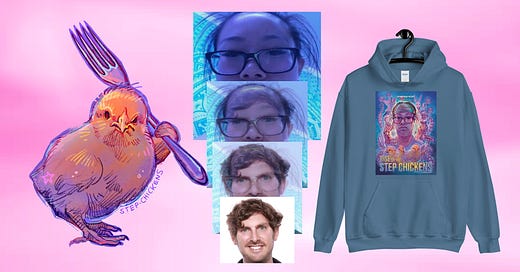Why influencers are replacing fans with cults
Josh Constine's Moving Product newsletter #4: Rise of the Stepchickens, Itsme avatar dating, and a flavor synethesizer.

How did a ridiculous app called Stepchickens break into the top 100 apps on its first day? The power of cults.
If an internet celebrity or content creator doesn't get paid per view, then "fans" aren't worth so much. Revenue sharing platforms like YouTube and Twitch reward influencers for having legions of casual followers who rack up ad impression. But you need a different strategy on platforms like TikTok, Twitter, Instagram, and Snapchat that don't share ad revenue, where calls to action are limited, and most people just want to like, maybe share, and keep on scrolling. If a creator wants to make sponsored content, they could monetize their reach, but that requires business savvy, brand safety, and creative compromise.
That's why influencers don't just want fans. They want a cult. They want loyalists willing to do as they command, withstanding the friction of leaving their favorite feed to take actions that benefit their glorious overlords. While the term ‘cult’ might be a bit insensitive, it appropriately describes the obsessive devotion that communities give to their charismatic leaders. In exchange, they dispense a sense of belonging. Yes, TikTok is keeping kids out of gangs by getting them to join cults.
THE RISE OF THE STEPCHICKENS
This month, a former Googler who left her job to become an influencer comedian suddenly became a cult leader. ChunkysDead aka Melissa had been making TikToks since November, scoring some hits with edgy life advise like “If you are not happy single then you will not be happy in a relationship because happiness does not come from relationships, it comes from drugs.” But her following really started to grow when she’d activate her early fans to ask other influencers to duet her, or play pranks like getting 7000 people to tag a specific person in the comments of a goat video.

That led ChunkysDead to invent the “TikTok cult” on May 8th, formalizing a community for her henchmen. She crowdsourced the Stepchickens name from her followers and asked them to change their profile pic to match hers — a distinctively blue-lit ugly selfie. Calling herself Mother Hen, she declared war and commanded the cult to overwhelm the comment sections of For You page videos.
The Stepchickens soon inspired competing TikTok cults, leading to “Battle Zones” where the leaders would choose a random video and see whose cult could drown the comment reel with their profile pics. The battles are even expanding to YouTube. Melissa tells me that her polarizing comedy attracted the breed of hardcore fans willing to join a cult. “I think the reason I have such a loyal following is because I’ve been creating a consistent and specific brand of humor over time. It doesn’t sit well with everyone, but those who do like it are very into it.”

That’s when Melissa upped the ante with the help of Sam Mueller, the developer of Blink, an app for building your own chat and meme sharing micro-community. They’d known each other from working together at Yahoo, so Sam reskinned Blink as Stepchickens and let Melissa relaunch it as her own app on May 18th. No other cult could match that.
110K active Stepchickens have since sent over 150K text and video messages in the app, with many buying cult merchandise from Melissa’s online store. The app crested to the #9 US social app and rose above Quibi in the overall charts, while helping Melissa add 1 million new TikTok followers in just two weeks.
Cults > Fans
“Melissa has tapped into the zeitgeist of bored teens in quarantine and given them purpose.” Mueller tells me. Craving community, the app let them “gather and have conversations with each other rather than exclusively interacting with the broadcasts on TikTok.”
We’re going to see more creators try to prod their followings along this path from fan to cultist:
Consuming - Serendipitously discovering a creator's content
Following - Subscribing to a creator across channels
Sharing - Re-distributing a creator's content consistently
Creating - Amplifying a creator via remixes and references
Affiliating - Joining communities of a creator's allies
Buying - Spending to support a creator or prove allegiance
Transforming - Redefining one’s identity around a creator

Unlike with traditional celebrity fandoms, the blurrier line between influencers and their followers creates a sense of relatability and intimacy that drives a cult to go to war for them. The personalized, self-selected nature of social media engenders a deeper connection than old school stars can generate through mass media. The fast feedback loops of micro-entertainment apps like TikTok let leaders quickly turn community input into fresh content that makes their cults feel seen. And by fostering a sense of fellowship through peer-to-peer communities, influencers can keep their cults satiated even when they’re not churning out videos.
This drives the wholistic sense of alignment with an influencer that gets people to open their wallets to purchase merch or Patreon subscriptions. With so many of the possessions that used to represent us like record collections going digital, Gen Z is eager for new ways define themselves.
App Of The Week: Itsme
A dating app that instantly throws you into video chats with your matches would be pretty intense and potentially awkward. But not if your face is replaced with an auto-generated, customizable 3D avatar. Itsme makes those same video chats more comfortable and funny, and lets you connect on Snapchat if you hit it off. By replacing text pickup lines with more exciting live interaction, and thanks to the [[Quarantine Concurrent User Loan]] I wrote about last month, Itsme recently broke into the top 20 US social apps. Online dating is becoming less stigmatized and people are starved for human interaction while stuck at home, but our shyness persists. That’s why we’ll see more interest in apps that blur people’s pics at first like S’more and Blindlee, or replace them with avatars like Eternal and Itsme.

Deep Thoughts On: TikTok making search obsolete
Turner Novak of Gelt VC has writen the must-read deeeeep dive into TikTok. It’s almost an eBook with tons of fascinating tidbits from parent company ByteDance’s inception to the app’s savvy engagement hacks. It also indexes all of ByteDance’s new product attempts as it strives to grow beyond TikTok into a Google-like empire of apps encompassing consumer finance, education, music, gaming, and enterprise software.

The most important passage is perhaps this one on how TikTok’s AI lets it rapidly learn what you like without explicit input:
Zhang, ByteDance’s founder and CEO, has stated his primary strategy is to eliminate the need for search - how Google and Amazon serve their very profitable advertising products - and immediately serve users exactly what they want.
Imagine this applied to commerce? With no search bar, an app could just track your swipes, hovers, taps, and buys to curate a shopping feed. An AI-powered standalone commerce product could bullseye your taste in clothing much faster than apps that mix shopping with friends’ posts or inspirational images like Pinterest. In fact, this is why Instagram is building a dedicated shopping feed, as announced by Mark Zuckerberg this week (though it was overshadowed in media coverage by other efforts to help small businesses). Luckily, Jane Manchun Wong had spotted a prototype of this feed inside the @Shop page on Instagram.

WTF Product: The Norimaki Flavor Synthesizer
What if you could build a vape-like device for simulating any food’s taste? The way screens make any image from red, blue, and green light, researcher Homei Miyashita has prototyped a device that’s uses chemical gels to recreate sweet, salty, acidic, bitter, and umami flavors. An electrical current in the device can retract the flavors in different quantities to create precise tastes like gummy candies.
I think the research could one day have implications for weight loss programs like [SignalFire-backed] FORM Health, perhaps by letting people get a simulated taste of chocolate to fulfill a craving without the calories. Disclaimer: The experiment and research weren’t rigorously repeated or peer reviewed, but it still feels like we’re one step closer to the Star Trek replicator. via Gizmodo’s Andrew Liszewski

Constine’s Corner
Thanks again to everyone reading this for helping me find my voice, post-TechCrunch. The newsletter hit new records for views and open rate last week, and I’m deeply grateful for your time. I’m already loving the endless learning of VC life at SignalFire. Next week I’ll be lending a hand moderating a talk for our portfolio company Commsor, a suite of tools for managing online communities. Register for their community leaders summit to catch my talk at 9am PT on June 4th with Y Combinator’s Kat Mañalac and more.

Meme of the week
Sorry I made this. But hey, if you learn from mistakes, maybe this is a winning strategy.

Feedback? Ideas? Got something cool to show me? Reply here or hit me up on Twitter. You will not be asked to join my cult.




hi
Excellent article and very accurate in its content. There are very few of us in the world that possess this type of unusual expertise dealing with the phenomena of deadly cults. As a international renown author, private detective and expert Cult Investigator I can say that many Satanic underground groups are still very active in the USA and UK. https://youtu.be/hYjr2BL-upI
www.CharlesDelCampo.com As an an Investigator, I have been on national television, CNN, RT, Telemundo, Univision and other television and radio programs exposing many of these malefic underground cults being operated by sinister demagogues. Several of these groups operate clandestinely (using mind-control techniques) since they fear to be targeted by law enforcement agencies. Many of them possess vicious platforms of being radical, while alienating the recruit from family members and social friends. The deceptive practices are well camouflage!
The indoctrination process of brainwashing the target (victim) is very effective alongside religious fanatics; while others are evil worshipers. Moreover, these cults are highly trained in order not to be detected, while others engage in abducting children for ritual sacrifices as "La Santa Muerte" from Mexico and "Palo Mayombe" from Florida, USA. Unfortunately, the FBI is well informed of these malicious undertakings and their horrific crimes yet many times refuses to get involved!
https://youtu.be/HK_pSj7ee7Y
Like so, I been involved in several search & rescue operations (extraction) of victims while repatriating them to their family members. Along these lines, the psychological deprogramming is also a long process combined with reintegration of the target"s progress. See the below interview to corroborate the evidence of such bizarre events. https://player.fm/…/occult-crimes-interview-with-charles-de…